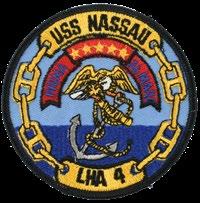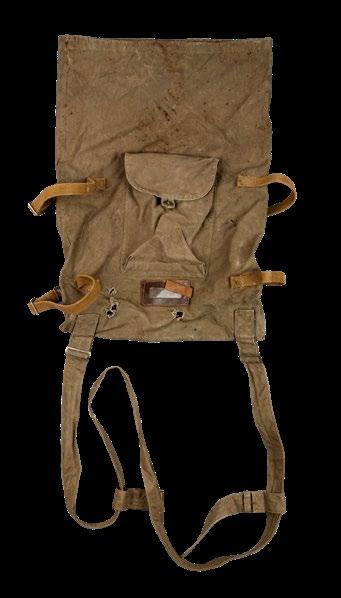
5 minute read
COLLECTIONS FROM THE
from The Bugle Fall 2023
By: Andrea Hoffman Collections Manager
“I know there are no words that can express our sorrow and grief over the loss of those splendid young men and the injury to so many others…Likewise, there are no words to properly express our outrage and, I think, the outrage of all Americans at the despicable act, following as it does on the one perpetrated several months ago, in the spring, that took the lives of scores of people at our Embassy in that same city, in Beirut.” – President Ronald Reagan, October 23, 1983
Advertisement
Forty years ago this fall, in the midst of the Lebanese Civil War, suicide bombers destroyed buildings that housed U.S. and French military personnel who were stationed in Beirut as part of a multinational peacekeeping force. The barracks for the 24th Marine Amphibious Unit (MAU) Battalion Landing Team (1/8) was one of the bomber’s targets. The Marines lost 220 of their own in addition to the 18 sailors and three soldiers who were killed. October 23, 1983 proved to be the deadliest single day for the U. S. Marine Corps since the Battle of Iwo Jima. The continued breakdown of local order led to the withdrawal of their replacements, the 22nd MAU, by February 1984, and yet a contingent of Marines stayed to continue providing security at the U.S. Embassy.
The amphibious assault ship USS Nassau (LHA-4) brought 115 24th MAU replacements for such duty to Beirut during the spring of 1984. For U.S. Navy Boiler Technician David R. Homan, Jr., a petty officer first class from Racine, Wisconsin who had boarded Nassau that January, his April 7, 1984 arrival off the coast of Beirut marked his second time there in two years. Homan was previously in the region during the summer of 1982 on USS Biddle (CG-34), a guided missile cruiser that escorted refugees of the Palestinian Liberation Organization (PLO) fleeing to Tunisia. Upon his return, Homan was already well acquainted with the serious tensions across the Middle East at the time.
Beirut wound up being the site of an incident that nearly cost Homan an eye and later earned him a Purple Heart medal. He was on the ship’s deck during a fire fight that erupted onshore. When machine guns suddenly turned and struck his ship, shrapnel hit him in several places and caused him to fall to the deck below. The pain in his back initially distracted him from shards of glass that went in his eye when his glasses shattered, but that was the more severe of his injuries that day. He needed a cornea transplant and three weeks of recovery.
These injuries were far from the only ones Homan would incur during his 22 years of service, with his work in the boiler room proving hard on his body. From the time he enlisted in 1974 until the day he was transferred to the Temporary Disability Retired List in 1991, he developed a heart condition due to repeated heat stroke, suffered permanent nerve damage to his legs and hands, and broke his back twice. These injuries meant Homan did not return to the Middle East again during the Persian Gulf War, but instead spent three months at the end of
1990 into early 1991 recovering at Bethesda Naval Hospital. During the same period, the fifteen years of civil war and mass violence he had witnessed firsthand in Lebanon also finally ended.
Homan was honorably discharged in 1995 with the rank of chief petty officer. He returned to Racine and worked as a boiler plant inspector and volunteered for the U.S. Coast Guard Auxiliary for 17 years.
He said, “It wasn’t the navy, but it was as close as I could find.”
"The unique pieces in Homan's collection remind us of the lesser know yet important events where Wisconsin was there."
(Previous page) Photograph of Homan from the 1984 USS Nassau Navy Cruise Book.
(Top, left) USS Nassau patch (V2010.97.9)

(Top, right) Multinational Peacekeeping Force patch (V2010.97.8)
(Center, right) Multinational Peacekeeping Force Lebanon commemorative ashtray acquired in Beirut in 1984, cast by a local vendor from brass casings he stated were found after gunfighting. (V2010.97.17)

(Bottom, left) USS Nassau Zippo lighter (V2010.66.8),
(Bottom, center) Earlier-model coveralls worn by Homan in the boiler room, soon to be replaced by lighter weight Nomex models in the early 1980s (V2010.97.22)
(Bottom, right) Unit Identification Mark (V2012.65.2)
Forty years ago in October 1983, two incidents involving U.S. service members became headlines and were some of the first instances that tested U.S. military resolve after the end of the war in Vietnam ten years earlier. These incidents directly touched Wisconsinites.
Early Sunday morning, October 23, 1983, suicide truck bombs struck buildings in Beirut, Lebanon that served as barracks for U.S. Marines and French service members serving under the peacekeeping Multinational Force (MNF) during the Lebanese Civil War. The bombs killed 241 soldiers, sailors Marines. With 220 Marines killed it was the deadliest one-day toll for the Corps since Iwo Jima.
Wisconsin Veterans Museum collections have oral histories that demonstrate how top of mind the attack on the barracks in Beirut came to be for Wisconsin service members who had connections to others serving in the Mediterranean area.

Debra Wenzel from Appleton, Wisconsin joined the U.S. Army Reserves as a way of “wading in” to service as her oral history recounts. She met her future husband, an active-duty Marine, at the recruiting station. She was attending boot camp in the fall of 1983 when she heard that the Marine barracks were bombed. She was worried her future husband was on shore, as he had been stationed on the USS New Jersey j ust offshore at the time. She was reassured by others that he was on the ship and not at the barracks.
Yolanda Medina’s story illustrates that the Beirut bombing touched her life intimately. She and her husband signed up as Marines together. She was an aircraft technician. He was deployed overseas and was stationed off the coast of Lebanon, and in fact his ship was leaving when the attack happened. Medina says:
“So, his LHA [amphibious assault ship] turned back around, went to Beirut. And because of what he did and what he saw in S-1, he … [was involved in the recovery mission of those who were killed]. It affected him severely for the rest of his life. And at the time, you know, you're young, you're just happy he's home, you don't know what he's going through. But I knew that it was he was a different person.”
The two sides in Beirut were backed by the U.S. and the Western European countries on the one hand and the other by the Soviet Union.
On October 25, 1983 in another part of the world, the island of Grenada’s Prime the Organization of Eastern Caribbean States, Barbados, and Jamaica, the United States and the Regional Security System invaded Grenada. Like Beiruit, Grenada was also a proxy conflict of the Cold War. The Caribbean democracies and the U.S. were worried about the Cuban and Soviet influence in the country of Grenada and the Western Hemisphere in general. The Wisconsin Veterans Museum holds a Cuban rucksack picked up by Captain George Hill of the 82 nd Airborne. It ended
By: Jennifer Van Haaften WVM Assistant Director
(Center) T-shirt graphic, "Native Americans served with pride." (V2001.1.2)

(Right) up in the hands of Wisconsinite John Scocos who donated it to the museum. It could be considered an illustration of the Cuban influence on the island of Grenada at the time.

These two conflicts were an outgrowth of the diametrically opposed United States and the Soviet Union. The Cold War provided the roots for more conflict in the Middle East and the basis for continued hostilities that led to additional U.S. intervention in the Middle East in the 1990s and 2000s.

